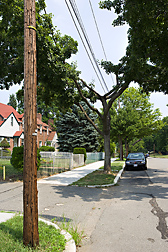Tough Trees
Finding smart plantings for urban spaces
Life on the street…it can be a rough existence. Even for trees.
Leafy city dwellers face a variety of assaults—from daily foot traffic pounding their roots, to extreme weather events such as limb-busting ice storms and debilitating drought, to the soot and salt that all urbanites must tolerate. Add to the list of stressors invasive insects—like the Asian longhorned beetle—or devastating disease, and it’s a wonder there’s any green life sprouting up from our cities at all.
That’s why ARS scientists at the U.S. National Arboretum (USNA) have spent 4 years studying various trees for urban-worthiness. Along with several partners—including the U.S. Forest Service, the Maryland Department of Natural Resources, the University of Maryland, Washington, D.C.’s Urban Forestry Administration, and local utility companies—these researchers have found some varieties that should be as naturally at-home on the streets as a cabdriver in New York City.
Giving more weight to this work is the fact that trees, woody shrubs, flowers, and other ornamentals constitute one of the fastest-growing segments of U.S. agriculture. Sales of these plants soared to more than $16 billion in 2005, according to USDA’s Economic Research Service.
|
|
Right Tree, Right Place
What’s called the “Power Trees Project” has multiple goals. Researchers involved are focused on finding appropriate plantings that are not only sustainable and low-maintenance, but also offer the many benefits humans want from green plants.
And the group’s findings couldn’t have come at a better time. Urban tree plantings—valued as shade-makers, air filters, and sponges for soaking up global-warming gases—are increasingly coming under the chainsaw as a result of pests, diseases, and conflicts with power lines. Poorly chosen specimens often outgrow the confines of streets, highways, and parks, leaving utility companies no choice but to severely prune or remove entire plants.
One Washington, D.C.-area utility spends about $20 million annually on tree trimming, removal, and replacements.
“It’s really a shame to see trees that have been unwisely planted having to be aggressively trimmed because of their interference with utility lines and other structures,” says John Hammond, research leader of the USNA’s Floral and Nursery Plants Research Unit in Beltsville, Maryland.
Hammond, who heads the research component of the Power Trees Project, describes the kind of massive loss that can result from poor planning. “Last summer, 79 sycamore trees were cut down at a local school because they threatened to cause power outages and other problems,” he says. Those trees have been replaced in part with USNA selections.
Cultivars That Make the Cut
Even before their tree hunt began, USNA scientists knew what they wanted: cultivars small-to-medium in size, with solid pest resistance and a tolerance for environmental extremes. A seemingly tough task, but a modest one for researchers with decades’ worth of tested varieties at their disposal.
“We considered many cultivars developed by arboretum scientists, such as maples, dogwoods, crape myrtles, elms, and cherry trees,” says Hammond.
Extensive information exists for all such releases; plant details are available to anyone curious about a USNA cultivar. Hammond and his team ultimately settled on nine cultivars suited for growing in a variety of geographic regions. In addition to identifying species that are suitable for urban environments, the researchers wanted to find out which nursery cultivation method—container or traditional in-ground planting—best prepared saplings for a life on the streets.
“We found that nursery trees started in containers grew better at our test nursery than those started in open ground,” says Hammond. “Container-grown trees, which can be set above or below the soil surface, don’t generally suffer the kind of root damage as do trees that must be dug up and bound in burlap for transplanting.”
Comparative survival and growth in street plantings at nine test locations will be evaluated over the next several years to see whether the growth advantage of the container-raised trees persists.
And despite their rugged nature, these trees are sure to wow city residents with either their soft spring charms or commanding autumn brilliance.—By Erin K. Peabody, Agricultural Research Service Information Staff.
This research is part of Plant Genetic Resources, Genomics, and Genetic Improvement, an ARS national program (#301) described on the World Wide Web at www.nps.ars.usda.gov.
John Hammond is in the USDA-ARS Floral and Nursery Plants Research Unit, U.S. National Arboretum, 10300 Baltimore Ave., Beltsville, MD 20705-2350; phone (301) 504-5313, fax (301) 504-5096.
Streetwise Trees
ARS scientists at the U.S. National Arboretum have identified several trees that will soon be known for their urban toughness and curb appeal. Developed by such arboretum breeders as Margaret Pooler, the late Don Egolf, and A.M. Townsend, these cultivars have proven they can meet the grueling demands of a life on Main Street while still offering an aesthetic that ranges from the soft to the spectacular.
Brandywine red maple (Acer rubrum)
Fast facts: USDA zones 4-8; reaches 25 feet tall; nicely shaped oval crown; provides dazzling autumn show with merlot-colored leaves.
Natchez crapemyrtle (Lagerstroemia)
Fast facts: USDA zones 7-9; reaches 30 feet tall; resistant to powdery mildew; produces clusters of pure-white flowers from June to September; has attractive cinnamon-colored bark.
Dreamcatcher flowering cherry (Prunus)
Fast facts: USDA zones 6-9; reaches 25 feet tall; nicely defined vase shape; produces medium-pink, single flowers from late March to early April; bears small fruits that attract birds.
Frontier elm (Ulmus)
Fast facts: USDA zones 5-8; reaches 25 feet tall; nice symmetrical shape; sports enduring reddish-brown fall foliage.
For more information, or to learn about additional species, visit the Power Trees Project at www.powertrees.com.—By Erin K. Peabody, Agricultural Research Service Information Staff.
"Tough Trees" was published in the October 2007 issue of Agricultural Research magazine.










